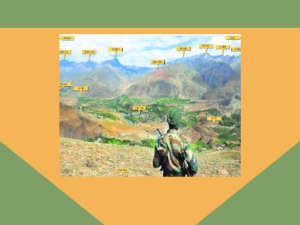GREAT FOUNDERS OF FREEDOM STRUGGLE OF INDIA
Baba
Sri Chand Ji was a great saint, patriot and freedom lover. He had
great love and dignity of his country, his people and his nation. His
love for this country and the nation could be noticed in the event of
his meeting Samrath Ramdass the teacher of Chhatarpti Shiva ji
Maratha and preaching him and Maharana Partap. Baba Sri Chand was
the eldest son of Guru Nanak and like his father took upon Udasis
(travels) to spread his message all over the world, hence his
followers were known as Udasis. Guru Hargobind was the sixth Nanak in
succession. He too took
upon weapon to relieve the country of the oppression and tyranny of
the Mughals and to make Indians free.
During Guru’s period the country was under the rule of foreign invaders the Mughals and they treated Indians as slaves. Guru Nanak had raised the voice against their oppression and tyranny. Guru Nanak believed in ‘sabhna jia ka eko data’ There is only One Lord of all universe. he said:
Those who worship become Him “jaisa sevai taisa hoe” (Gauri Ashtpadi, vii-4). Guru wanted his followers to be fearless and without enmity with anyone. Guru Nanak did not believe in high or low, caste, creed and colour division. “Nonsense are the castes and nonsense are their names.” (Sri Rag, 4-3) recognize divine light in everyone and do not enquire caste. There is no caste in the next world. (Asa 1-30) Guru Nanak was not afraid of the rulers. He spread the philosophy that it is not the kings but the God who is greater of all. If the people have to fear they should be afraid of God alone and none else; not from the earthly figures who are bound to die. Creation of icon God greater than the kings brought a change in the thinking process of the public that it is God who is the Creator, Developer, Protector and the ultimate Destroyer of all, even of the kings. Why should one be afraid of the kings then? He reprimanded the kings and their courtiers acting as lions and dogs and do not provide equality to the public. When Babar attacked India third time and destroyed Saidpur killing or making slaves all and sundry, Guru Nanak reprimanded the Lodhi Rulers who did not stand to save their public against the attacker.
“If a powerful person were to attack another equally powerful person, there will be no ground for grievance, but if a ferocious lion were to fall upon a herd of cattle, the protector of the cattle should be answerable for it.” (Asa I, 39, 42) He further said: “The dogs (Lodhi Rulers) have thrown away the invaluable gem. When they are dead and gone, no one will remember them with regards.” (Asa, I, 39, 42). Martyrdom of Guru Arjan had proved that Mughal kings did see no reason. They were barbarous; and tolerated no opposition. Even at a slight doubt they levied death punishment. This was gross injustice.
Guru
Hargbind saw that there is no alternate to self defence; he has to
protect himself alone but also the public. Following Guru Nanak’s
guidance that the poor and oppressed must be protected, Guru
Hargobind raised weapon against the tyranny and oppression. He learnt
battle tactics and war strategies, kept weapons and horses: and wore
two swords, one depicting spiritual strength and the another;
depicting the temporal strength. According to Maubid Zulfdiqar,
“The Guru kept seven hundred horses in his stables; three hundred
cavaliers and sixty artillery men always at his service.” This was
the first step towards making Sikhs as saint warriors.
Once Guru Hargobind was on his way to Nanak Mata from Punjab. At Sri Nagar Garhwal he came across Samrath Ram Das going to Badri Nath-Kedar Nath. Accompanied with followers some of them armed, Guru Hargobind was riding a horse fully armed. Samrath Ram Das was a traditional hermit. Guru Hargobind was introduced to him as Nanak the sixth. He was astonished to find Sixth Nanak armed and riding a horse as can be found from the details in 39th sakhi of Fifty Sakhis:
As the oppression and tyranny ‘Once Guru Ji stayed at Kashmir (Garhwal). A hermit came to visit him. He was South Indian, Ram Das by name. Guru Nanak was riding a horse returning from hunting. The followers also followed in number. Samrath Ram Das raised a question, “I heard that you on the seat of Guru Nanak. Guru Nanak had renounced the world. You are wearing weapons and have horses and an army. You allow yourself be called the True King (Sacha Patshah). What sort of hermit are you?” Guru Hargobind replied, “Internally a hermit; externally a prince. Arms are for protection of the poor and oppressed and destruction of the tyrant. Guru Nanak did not renounce the world; he had renounced maya (the self and ego). Ramdas was pleased to hear this and said, “This does appeal to my mind.”[1]
Shri
Hanumant Swami in his Samrathanchi Bakkar has recorded in Marathi the
discussions between Guru Hargobind and Samrath Ram Das stating that
“the Guru had already the right type of instruction and advice from
the great master Nanak and that he needed none from himself.”
While departing, Ram Das presented a piece of ochre coloured cloth and a rosary as parting gifts to the Guru.
Samrath Ram Das also met Baba Sri Chand and discussed the relgion and the state of country and society with him. Baba Sri Chand inspired Samrath Ramdas to work for the upliftment and defence of his religions institutions along with meditating peacefully in temples situated in lonely places and to prepare someone as defender of the people who could bring the nation out of the existing turmoil.
Inspired by Baba Sri Chand’s words and discussion with Guru Hargobind, Ramdas returned to Maharashtra and established a chain of monasteries throughout the countryside where physical education was imparted with special attention to the formation of physical strength and character building. Among his trainees was Shivaji whom he found very dedicated and committed learner, mentally firm, physically strong and zealous freedom fighter with a religious bent of mind. In him he found the bright spark to create fire among his men. He thought him to be the right choice for carrying forward the message of Hargobind. He trained Shivaji on Guru Hargobind’s line and soon it proved right that as the fire of Shivaji ignited the minds of Maharashtra people, a uncontrollable freedom struggle against the Mughal rule. He not only shook the tall tree of Mughal empire but by up-rooting it, captured most of its terrain and kept under his able control.
Baba
Sri Chand Ji love for his country could be further gauged from the
proceedings of the meeting between him and Maharana Partap. Maharana
Partap ascended on the throne of Udaipur after the demise of Maharaj
Udai Singh in Bikrami 1629 (1572 A.D.). Chittaur had already gone
into the hands of Mughals in the time of Maharaja Udai Singh in 1568
A.D. All other Rajput princes had submitted to the Mughal Emperor
Akbar but Maharana Partap who was a brave, courageous
and self respecting prince did not lose his head and heart and took
an oath to fight the Mughal king till the fall of Chittaur, not to
sleep on a bed, not to keep his moustache and to have his food on
leaves only. He was facing heavy odds as his own brethren had fallen
with him and joined the forces of his #1 enemy. He had to face defeat
in the field of Haldi Ghati in 1576 A.D. and had to live in
wilderness for next twenty years. Baba Shri Chand ji reached Mewar
area from
Aby Parvat enroute his pilgrimage to Ekling. Maharana paid him a
visit on the advice of his Prime Minister Bhama Shah and narrated his
tale of woes.
After his woes, Baba Shri Chand Ji told him not to lose heart and to take up the arms again. Time was not far when he would regain the control of his lost empire. Brave people die once in their life time whereas coward has to die hundred times before his death. Giving him blessing, he asked him to be brave and keep fighting till he wins. Bhamashah, sitting by Maharana’s side was so inspired with the discussion that he donated all his wealth to Maharana Partap and requested him to continue with the fight. Blessings and encouraging words of Baba Sri Chand inspired the Maharana. With the monetary help from Bhamashah and his devoted soldiers, he regained almost all of his lost empire of Mewar.[2] Maharana Pratap became a disciple of Baba Sri Chand Ji Maharaj. [3] The noted scholar K.M. Munshi conforms that Maharana Pratap sought Sri Chand's blessings to fight against Akbar.[4]
Guru Hargobind used to pay visits to Baba Sri Chand occasionally and held discussions about the path of Guru Nanak. He used to take his sons also along sometimes. Later he handed over his elder son Baba Gurdita to Baba Sri Chand Ji to lead Udasis after Baba Sri Chand. This way Baba Sri Chand son of Guru Nanak and Sri Guru Hargobind created a never ending wave of freedom where Maharana Partap, Shiva Ji and Guru Gobind Singh emerged resulting in ouster of Mughals and creating independent Maratha, Rajput and Sikh kingdoms.
References:
[1] ‘ਏਕ ਬਾਰ ਗੁਰੂ ਜੀ ਕਸ਼ਮੀਰ (ਗੜ੍ਹਵਾਲ) ਮੇਂ ਟਿਕੇ ਥੇ। ਤਹਾਂ ਏਕ ਸਾਧੂ ਦੀਦਾਰ ਕੋ ਆਯਾ। ਦੱਖਣੀ ਥਾ ਰਾਮਦਾਸ।ਤਬ ਗੁਰੂ ਜੀ ਸ਼ਿਕਾਰ ਖੇਲਤੇ ਆਵਤੇ ਥੇ ਘੋੜੇ ਪਰ ਅਸਵਾਰ।ਸਾਥ ਸਿੱਖ ਸੰਗਤ ਬਹੁਤ ਥੀ।ਪ੍ਰਸ਼ਨ ਕੀਤਾ: “ਹਓ ਸੁਣਿਆ ਥਾ ਗੁਰੂ ਨਾਨਕ ਕੀ ਗੱਦੀ ਪਰ ਬੈਠਾ ਹੈਂ। ਨਾਨਕ ਗੁਰੂ ਤਿਆਗੀ ਥੇ।ਤੁਮ ਸ਼ਸ਼ਤਰ ਧਾਰਨ ਕਰੇ ਹੈਨਿ ਘੋੜੇ ਫੌਜ ਰਖੀ ਹੈ। ਸੱਚਾ ਪਾਤਸ਼ਾਹ ਕਹਾਵਤਾ ਹੈਂ। ਕੇੈਸਾ ਸਾਧੂ ਹੈਂ”। ਗੁਰੂ ਹਰਗੋਬਿੰਦ ਕਹਿਆ, “ਬਾਤਨ ਫਕੀਰੀ, ਜ਼ਾਹਰ ਅਮੀਰੀ। ਸ਼ਸ਼ਤਰ ਗਰੀਬ ਕੀ ਰੱਖਿਆ। ਬਾਬਾ ਨਾਨਕ ਸੰਸਾਰ ਨਹੀਂ ਤਿਆਗਿਆ ਥਾ, ਮਾਯਾ ਤਿਆਗੀ ਥੀ”। ਰਾਮਦਾਸ ਪਰਸੰਨ ਹੋਯਾ ਕਹਿਆ, “ਇਹ ਹਮਾਰੇ ਮਨ ਭਾਵਤੀ ਹੈ”। (ਸਾਖੀ 39, ਪੰਜਾਹ ਸਾਖੀਆਂ)’।
[2] http://shrichandarji.com/lok/naya/20eng.htm
[3] https://www.sikhiwiki.org/index.php/Rajputs
[4] http://shodhganga.in...5_chapter 1.pdf
Col dr Dalvinder Singh Grewal
[email protected] 9815366726





